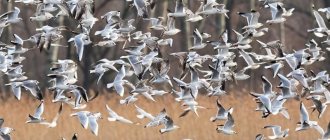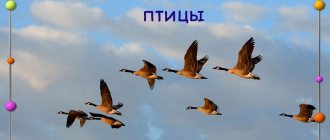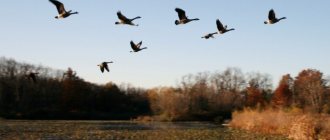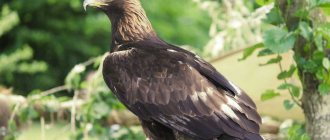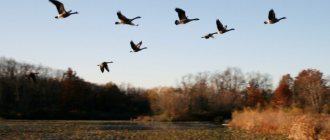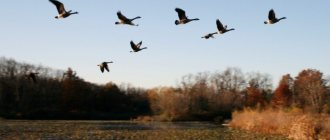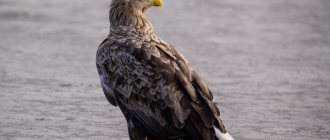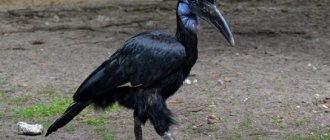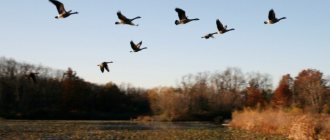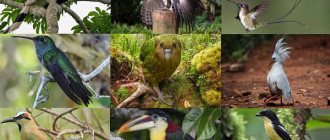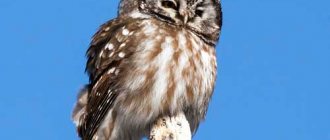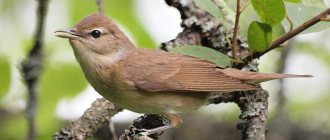Nature has designed the way of life of birds in such a way that many of them constantly migrate from one habitat to another, and this happens due to changing weather conditions. Since the temperature regime greatly affects the life activity and reproduction of birds, they usually leave their native lands when winter comes, and return back in the spring, in March-May.
The arrival of birds after wintering always means one thing: the cold has receded and made way for warmth. And here many people become interested in finding out which birds arrive first in the spring.
What birds fly from the South in spring, photo with title
Birds are warm-blooded creatures, therefore, with the onset of cold weather, they are forced to leave their habitable places in search of comfortable places with a warm climate, so as not to freeze and die from hunger.
But as soon as spring comes, the birds return to their homeland and their usual life begins: setting up a nest, hatching eggs, feeding and raising babies. And all these troubles are accompanied by extraordinary life-affirming chants. Interesting fact: all migrating birds return to their old homes, following their internal schedule. Each species of migratory bird has its own flight time. Moreover, birds love old places of residence and nests in which chicks were previously hatched. If for some reason the home is destroyed, restless workers build new nests.
Wagtails and rooks are the first to arrive from warm countries, when the first thawed patches appear in the snow cover. Starlings , different types of ducks , larks return with the first warmth even when the ice has not yet melted.
Greenfinches and linnets also arrive from the south before the ice melts on the rivers. Birds with colorful plumage return from the countries of the northwestern part of the African continent, northern Iran and Central Asia, where they spend the winter.
The cuckoo is a prominent representative of migratory birds arriving in the summer from Africa and the Asian tropics.
Blackbirds spend their wintering grounds in the south. In early spring they gather in large flocks and return home. Redstarts return from African countries and South Arabia, where they go for the winter at the end of August.
Nightingales prefer to fly to hot Africa for the winter.
Finch
With a length of 16 centimeters, the bird weighs approximately 25 grams. Accordingly, the finch's feathers are tiny, but worth looking for. This is what our ancestors thought. They picked up the blue and green feathers of finches as amulets for the hearth.
There is also beige-orange paint on the bird's body. The finch's breast feathers are "drenched" in it. There are black spots on the head, wings and tail.
There are white stripes on the bird's wings. This is a distinctive feature of finches. There are more than 400 species in the world. In Russia, the bird is considered one of the most common. Finches fly to Africa for the winter. Birds travel in small flocks.
Migratory birds fly after caterpillars, beetles, larvae, flies. Birds only have insects on their menu. True, the finches themselves are also in danger. The bird often becomes a victim of large predators due to carelessness while singing. Emitting trills, finches throw back their heads, ceasing to pay attention to what is happening around them.
Listen to the finch singing
The finch often becomes a victim of predators precisely while singing, as it becomes very distracted and throws its head back
What birds fly from warm countries in spring
Birds migrate to warm countries and, with the onset of winter conditions, are deprived of their usual food. These are all insectivorous birds: flycatchers , swallows , swifts , nightingales , warblers and other birds.
In winter conditions, these birds have no chance to survive, so flying to countries with a warm climate is an evolutionary reflex developed over a long time. Western Asia, the Mediterranean coast, the African continent are the places where birds go to wait out the winter. Migration of birds from warm places of temporary habitat occurs with the cessation of cold weather and the onset of spring. From the end of March to the first ten days of May, a massive return of birds from warm countries begins.
When flying away from their native nesting sites, migratory birds have to travel long distances and fly across seas and desert areas. New winter habitats for migratory birds must correspond to the usual temperature climate of their native places. Thus, forest birds settle in warm wooded areas, and coastal birds - on the coasts of rivers, lakes, sea and ocean islands.
We will show photos of migratory birds wintering in warm countries.
Lapwings arrive from southern countries in early spring.
They can be seen even in March during solar thaws. It happens that incoming cold weather, replacing short-term warming, forces lapwings to return to the nearest wintering grounds. Most often this is the Mediterranean coast. All species of blackbirds winter in warm countries. The most common species in Russia are: black thrush , song thrush , black-throated thrush , white-bellied thrush , Japanese thrush , brown thrush , etc.
White-browed thrushes are small birds from the thrush family that fly to the African continent for the winter in late autumn. They like to build nests in sparse birch forests.
Warblers are inconspicuous birds that can imitate the calls of other birds. They fly to India for the winter.
The corncrake flies to Africa for the winter. A small secretive bird that lives in thick and tall grass.
Warblers are small songbirds. following species live in Russia: garden warbler , gray warbler , lesser warbler , and black-headed warbler . Birds feed on small insects, caterpillars, and larvae. When the berries ripen, they switch to the sweet menu. They spend the winter in African territories.
Wood Accentor
It is confused with the forest pipit, warbler, and warbler. The Accentor is one of those birds that only ornithologists know, although it is common in forests. Hunters come across birds along with goldfinches and buntings.
The bird's appearance is inconspicuous. The plumage is brown-gray. The size is small. The body weight of the Accentor does not exceed 25 grams. Many people confuse a bird with a sparrow. There is a deal of truth in it. Accentor belongs to the order Passeriformes.
The Accentor feeds on insects. This prompts the bird to fly south. However, the bird stays until the coldest weather and returns early in the spring. True, this backfires on the Accentor. Having arrived, the bird immediately lays eggs. There is no vegetation yet. It is impossible to hide the masonry. The eggs are eaten by predators. Chicks hatch only from the second clutch.
The Accentor's tolerance to cold is reinforced by its ability to change its protein diet to a plant-based diet. Instead of insects, the bird can eat berries and seeds. Therefore, in regions with a temperate climate, dunnocks do not fly away at all. Birds from the northern regions of the country are flocking to the south.
Few people know the Accentor, it is very similar to a sparrow, and is often confused with a more familiar bird
Which migratory birds are the first to arrive in the Moscow region in spring?
Before the snow had even melted, flocks of wagtails .
These birds are the first to fly from distant countries. You can often see small, nimble little birds on blocks of melting ice floating along rivers: gray with a white chest and forehead, as if wearing caps and a black beard. White wagtails settle near water bodies and human habitation. Birds make loose nests in crevices of walls, under bridge rafters, in depressions on the ground, in hollows, bushes, and under tree roots.
Rooks are also early guests in the Moscow region. Quite large black birds with a purple tint of plumage arrive with the first thaw. A strong beak allows birds to find worms, larvae and insects crawling out into the sun in sun-warmed thawed areas. On old tall trees you can see mass settlements of rooks made from dry branches - “rooks”.
Starlings are small, beautiful songbirds with black plumage that has a metallic sheen with bronze, purple and blue hues.
White spots greatly decorate starlings, which disappear during the spring molt. An unusually wide sound range allows starlings to imitate various sounds and even the singing of other birds. Upon returning from warm wintering grounds, starlings often imitate the singing of their subtropical counterparts. Male starlings are the first to arrive and set up a nest house. The females then return and immediately begin incubating the eggs.
Larks usually return to their native places in the first ten days of April. The arrival of birds is accompanied by ringing singing, spreading over the fields from heavenly heights. A small bird the size of a large sparrow has an elegant crest on its head. Field birds feed on the seeds of last year's grasses and cereal plants in thawed thawed patches. Finches arrive along with larks, thrushes, and swans in early April. The elegantly colored bird is a decoration of our forests. The plumage of males is brighter than that of females. The chest, part of the back and head have shades of brown-red color. The finch is decorated with a bright blue cap and a green tail. Finches willingly settle in gardens, parks and forest areas. They can often be found near human habitation. Blackbirds are birds with a mesmerizing song that fly in after the finches. The thrush's feathers have many shades: from brown to almost black. The thrush nests in massive nests in bushes or directly in depressions on the ground, using clay and earth to seal the side walls of the home.
Redstarts are nimble, beautiful birds from the passerine order. The tail and tummy seem to glow orange. It is on this basis that the birds got their name. The birds are distinguished by a gray-white head and some white feathers in the bulk of black wings. They fly to their native lands in April and announce their arrival with loud chants even at night. Swallows arrive, heralding spring, in early to mid-May. Beautiful birds settle near human habitation and make nests from pieces of clay, earth and blades of grass. Near rivers and reservoirs with steep overhanging banks you can often see numerous settlements of swallows. This is the best time to catch small insects, which swallows catch without stopping their flight.
Pied flycatchers come to us when it is time for a mass appearance of insects and flies. It is not for nothing that the small, inconspicuous gray-brown bird got its name. The male looks more elegant - contrasting white and black feathers, a white forehead and part of the feathers in the black wing. Insect larvae and flies are the main food for birds.
Nightingales are gray, inconspicuous birds with a marvelous, bewitching song that appear in our forests in the second ten days of May.
To build a nest, birds choose wet bushes near rivers. Insects, spiders, berries and small plant fruits are the main food for birds. The first migratory birds of Russia, video:
City swallow
The bird has black plumage on its back and white on its belly. The tail has a triangular ending. The city swallow, or swallow, is not adapted to walking. Their life is spent in flight. Birds catch insects in flight and even drink water. The swallow lives in populated areas throughout Europe. She makes nests from clay and earth on stone buildings. The birds arrive in mid-spring and occupy last year's nests. Departure to Africa is in mid-September.
What birds fly to Siberia in spring
The return of feathered singers to the Siberian region indicates the end of winter cold and the arrival of warm days. The harsh Siberian winters are a real test for birds. The most important thing is not even the excessively sub-zero air temperature, but the problem of food. Many little birds die of hunger, since the snow cover covers all possible places of food for a long time.
The Black-throated Loon is a beautiful bird with elegantly colored feathers. At the end of September, the loon migrates alone or in pairs, gathering in large flocks to rest near water bodies. For wintering, birds move to the coastal zone of the Black and Azov Seas. Some loons fly closer to the Caspian and Aral seas.
The common goldeneye is a large-headed duck with brownish-gray plumage. Lives and nests near taiga rivers and forest lakes. They migrate to the Caspian Sea for the winter. The coot is a representative of waterfowl. The white forehead and beak stand out in contrast against the black shiny plumage. It spends the winter in warm countries: India, Pakistan and Southeast Asia. Klintukh is a pigeon that lives in forests and parks. Leads a cautious lifestyle and hides in dense foliage. It winters on the Caspian coast and even reaches the central and southern regions of Europe. Returns home in March-April.
The nightjar is a nocturnal, inconspicuous bird with large eyes, a large mouth, a small beak and short legs. It lives in pine forests, feeding on insects. For the winter it goes to Africa, flying around the Sahara.
Fieldfare
This is a blackbird. The bird is active, seems fussy, and constantly repeats “chuck, chuck, chuck.” The characteristic sound gives away the fieldfare. Most often, a din of many voices is created. Pairs of birds nest next to each other. There are usually 30-40 families of fieldfare in a colony.
Listen to the singing of the fieldfare
Birds settle in copses and parks. Approximately half of the individuals survive the winter in Russia, wandering from place to place in search of food. The other half of the blackbirds fly to Asia Minor and northern Africa.
Fieldfare have developed a unique way of protecting themselves from enemies. The birds spray them with their droppings. This is what blackbirds do, for example, with crows. The latter feast on both fieldfare and their eggs.
What birds fly to the Urals in spring
The length of the Ural Mountains is great: from the tundra to the steppe zone of Kazakhstan.
It is not surprising to find many nomadic and migratory birds here. The harsh and unpredictable climate, frosty, snowy winters force birds to migrate to warm countries and return to their native places in the spring. Let us list the bright representatives of birds that return to the Urals in the spring. The whooper swan is a beautiful white bird with black legs that lives in ponds. The lemon yellow bill fades into a black tip. Only after two years the wings of whooper swans become snow-white. Wintering is carried out in the Caspian Sea or on the Mediterranean coast. Many whooper swans fly to the reservoirs of the Bird Harbor near Omsk and stay until spring.
The little swan or tundra swan also returns to the Urals in the spring, where they nest near bodies of water and raise their chicks.
Osprey is a predator that lives near rivers and lakes abounding in fish. For the winter, it flies to Africa and returns to the Urals in May to its old nesting site. Buzzards are medium-sized birds of prey. They feed on the larvae of bumblebees, wasps and bees. Sometimes they feast on small lizards, frogs, and mice. In cold, rainy weather they may abandon a clutch of eggs. The snowy owl is another exotic species that lives in the mountain-tundra Urals. A beautiful Arctic bird with snow-white plumage with patterned black and brown patches throughout the body. For the winter it flies to southern countries, and returns in the spring to hatch owlets.
What birds fly to Belarus in spring
The bird world of Belarus is represented by a wide variety of birds.
Favorable natural conditions, dense forests and numerous bodies of water contribute to the life and nesting of many birds. However, harsh snowy winters are a great challenge for many birds and they are forced to fly away in search of warmer climes. Almost 200 species of migratory birds have been recorded in Belarus. Starlings, lapwings , larks , ducks , and geese arrive in March with the first thawed patches. Birds wintering in Africa arrive later. These are mainly insectivorous birds: storks , cuckoos, robins , blackbirds , etc. In the second half of spring there are already enough insects, worms, and larvae to feed these birds. The last to arrive in Belarus are black swifts and swallows . Their arrival occurs in late April-early May.
The white stork is the symbol of the Republic of Belarus. The beautiful snow-white bird has a wide black edging on its wings, the span of which reaches 1.5-2 m. Storks have a thin reddish beak and long bright legs. Birds live near bodies of water in the lowlands. They often build nests near human dwellings. Storks fly to India and Africa for the winter.
The red-headed duck is a duck with a long neck and an inconspicuous tail. Drakes look very elegant: a red-brown head, a black chest and white plumage on the sides. Females look modest and inconspicuous. Ducks winter in Africa, Japan, western and southern Europe.
Crossbills
The pine crossbill has a powerful beak and easily copes with cones
Crossbills are common in coniferous forests of Eurasia and North America.
They have a very characteristic beak structure: the mandible and mandible cross, forming an excellent tool for removing seeds from cones.
Many granivorous birds feed their broods with insects (they are more nutritious and easier to digest), but crossbills feed their chicks with coniferous seeds, which is why they nest in the winter, when their main food is ripe.
What birds fly to the North in spring
The harsh living conditions of northern latitudes force birds nesting in this territory to leave their homes and migrate to places with a comfortable climate for bird life. Kittiwake gulls build nests on the coastal cliffs of the Kola coast, and in order to survive the harsh winter of the far north, they fly to the northwestern Atlantic and even fly to the western coast of Greenland. With the onset of spring, large flocks of kittiwakes return to their homes. The Arctic tern is a typical representative of birds of northern latitudes. Red legs and beak adorn the white and gray bird from the gull family. For the winter, the bird migrates to the Southern Hemisphere, covering vast distances and settling for the winter in the waters of the Southern Ocean.
The small buzzard is a predator that migrates to Africa or South Asia in the winter. Habitat: hilly coniferous forests interspersed with open areas. It feeds on small vertebrates: gophers, mice, small birds. The buzzard's voice resembles a cat's meow. When migrating to warm regions, birds create large flocks and fly away at the end of September.
Owls
The owl's eyes are huge and keen, he sees perfectly both day and night
Owls are nocturnal.
Among them there are both very small birds, about 12 cm in size (elf owl), and large ones, up to 70 cm in length (fish owl).
Owls feed mainly on rodents, as well as reptiles, insects, and small birds. Soft plumage makes their flight almost silent. The paws of owls are armed with sharp curved claws. Owls' eyeballs are motionless, so their angle of vision is small.
This disadvantage is compensated by the incredible mobility of the neck; the owl can turn its head 180-270 °C. A peculiarity of owls is the asymmetrical arrangement of the auditory openings.
Thanks to this, owls, even in complete darkness, accurately determine the position of the prey by sound.
What birds fly to Murmansk in spring
Murmansk is a city located beyond the Arctic Circle.
The location on the steep, rugged eastern cliffs of the Kola Bay and the temperate climate, moderated by the proximity of the Barents Sea, provide nesting opportunities for many unique birds. Dense forests and many lakes and streams also favor bird colonies.
Ornithologists of the Lapland Nature Reserve are carefully studying the migration of birds for the winter and their return. From the beginning of April, the active movement of birds to the polar region begins. The Bunting is a small beautiful bird with a snow-white chest and belly interspersed with black-brown feathers.
The sonorous trills of snow buntings can be heard from the beginning of April. Following the snow buntings, birds included in the Red Book of the Murmansk Region - whooper swans - , and in the last days of April - eagles . At the same time, the following birds are actively flocking to their former nesting sites: goldeneye , merganser , goose , mallard , gulls , and finches .
At the beginning of May,
the white-browed thrush and fieldfare .
Bullfinch
A small songbird with a red breast on males and grayish brown on females. These guys love all kinds of grains, especially ash seeds, as well as dried berries. They are not afraid of people and live in all city parks.
You will meet bullfinches in city parks. Photo: pixabay.com
What delicacies should you add to feed bullfinches?
- flax seeds;
- rape;
- berries of rowan, rose hips, viburnum;
- watermelon grains;
- pumpkin seeds;
- knotweed (annual plant);
- apple pieces.
Which birds are the last to arrive to us?
The movement of birds to their native lands begins from the end of February to May.
Some birds feed on insects, larvae, worms, berries and fruits of plants that appear in late spring. Therefore, their arrival from distant countries occurs at a later time. Seagulls , geese , ducks , and cranes appear in their native places from mid to late April.
Warblers , tree pipits , and redstarts flock in early May. Warblers are miniature birds with a fragile build and a thin beak in yellow-green plumage. Insects are the favorite food of small birds.
Swifts , swallows , and nightingales return to their homeland in May. Swifts , like swallows, grab flying midges and insects in flight. Birds spend most of their lives in flight, taking beaks full of food and only then returning to the nest to feed their chicks.
Orioles and Golden Bee-eaters are beautiful birds with yellow plumage, the last to arrive from warm countries. The melodic singing of the common oriole is reminiscent of playing a flute, and is sometimes associated with the meowing of a cat. Midges, caterpillars, berries are delicious food for the tireless worker of the forests - the oriole.
The golden bee-eater is one of the most colorful and beautiful birds. Wild bees, wasps, bumblebees, dragonflies and other flying insects are the main food of the forest beauty, which swallows live food on the fly. Therefore, the bird moves early for the winter, and one of the last to return to its homeland when there is enough food for food.
Flamingo
The long legs of flamingos are equipped with special mesh membranes that help them walk on liquid clay without falling through.
Flamingos have a flexible neck, long legs and a swollen beak that is curved at the end.
The edges of the beak are equipped with small horny plates, forming an ideal filtering apparatus. Having lowered its beak into the water, the flamingo wanders through the shallow water on graceful legs, moving its head from side to side, straining small crustaceans from the liquid silt and water, which are its main food.
The pink or red color of the plumage of adult birds is provided by red pigments contained in the shell of crustaceans, and in captivity on a different “diet”, flamingo feathers may lose their color intensity or even become white.
Folk signs and migratory birds
A clear migratory schedule of birds has been noted since ancient times, therefore many folk signs are associated with birds’ arrival in their native lands. The onset of warm sunny days, the time of sowing cereals in the field and vegetable crops in the garden - observant people have associated the arrival of certain birds.
weather and migratory birds
Traditionally, the first birds to return from distant lands heralded spring and the arrival of warmth.
- Geese are calling for spring.
- Geese and ducks have returned not emaciated - expect a long and cold spring.
- A migratory bird moves in flocks - to a friendly spring.
- If you see a rook, notice spring.
- I saw a starling - spring is at the porch.
- The swallow has arrived - there will soon be thunder.
- The bird crows in bad weather.
- The larks have arrived - it's time to take out the hives.
- The finches have arrived - wait for the cold weather.
- A bird builds a nest in the sun - expect a cool summer.
- The jackdaws flew in and screamed for warmth.
- The nightingale is flooded all night - it will rain.
- The rook collects brushwood from the ground - it promises a sunny summer.
- Rooks are circling in a flock around the nesting site - it’s bad weather.
- The tit began to sing - to stay warm.
- The wagtail's legs are thin, but it will break the ice and bring spring.
- The larks began to sing early over the field - a warm spring is expected.
- Birds are in no hurry to fly south - it will be a warm autumn.
harvest and migratory birds
To this day, old people follow the tradition of sowing grains and other crops at certain times in the spring after migratory birds return home. And if you follow folk wisdom, you can grow an excellent harvest according to the bird's hint.
- The rooks have settled into the nest - in three weeks go out to sowing.
- The baby rooks are screaming - it's time to sow oats.
- The pied flycatcher calls for the start of plowing.
- The starlings have arrived - this buckwheat will arrive in 40 days.
- The chiffchaff began to crackle - these carrots and beets.
- The lapwings have arrived - prepare the turnip seeds for sowing.
- The oriole sang - it’s time to sow peas, cucumbers and cabbage.
- I heard the cuckoo singing on bare trees before Yegor (May 6) - don’t expect a harvest.
- The swift is circling en masse - it’s time to sow flax and barley.
- The cuckoo has crowed, the rowan tree has bloomed and the oak tree is opening - it’s time to sow flax.
- The birds returned from warmer climes on time - expect an excellent harvest of bread.
- The lark began to sing over the warm earth - it was time to sow grain.
What birds live in the garden
Many birds willingly settle around human habitation. In our gardens they have something to feast on: numerous larvae, harmful insects, worms, snails, slugs - and many more edible things can be found by the little feathered workers. The following birds live and nest in garden plots and nearby forests:
- wagtails
- goldfinches
- cuckoos
- warblers
- tits
- redstarts
- warblers
- sparrows and many other birds
Cuckoo
The question “cuckoo, how long do I have to live” is irrelevant in winter. The bird flies to southern Africa. By the way, only males cuckoo. Females of the species produce low-frequency sounds that are imperceptible to the human ear.
In terms of mating relationships, cuckoos are monogamous. Birds change partners. A male, for example, manages to fertilize 5-6 cuckoos per day. They prepare for mating in a unique way, choosing an area with an abundance of nests of other birds. The cuckoos throw their eggs into them and again go looking for a partner.
Listen to the voice of the common cuckoo
What birds are useful for the garden?
Birds living in gardens are very beneficial for fruit and ornamental trees and shrubs. After all, small birds find harmful insects for food on our estates. It has been noticed that the birdies living in gardens do not allow the codling moth, pear bug, ringed silkworm, raspberry gall midge, aphids, caterpillars and other garden pests to breed. In addition, feathered friends delight us with extraordinary trills. We list the useful birds desired for our gardens:
- tits
- wagtails
- redstarts
- warblers
- robins
- lentils
These birds protect our garden from pests and do not damage the crop. But there are also birds that willingly eat not only worms in our gardens, but also sweet berries. This is how starlings are known to have a great desire to feast on ripe cherries. And the prankish sparrows peck at the sunflower seeds.
Woodpeckers
The Great Spotted Woodpecker seizes its habitat - a forest area ranging from 5 to 15 hectares - and does not allow other woodpeckers into it
Representatives of the woodpecker family make holes in tree trunks, extracting insect larvae.
These birds have a beak as strong as a chisel, powerful neck muscles, and hard tail feathers and tenacious claws create reliable support. Having discovered a passage made by an insect, the woodpecker reaches its occupant using a long tongue serrated at the end.
The insect is either pierced by the tongue or sticks to it and is pulled into the mouth. Woodpeckers also feed on seeds of coniferous trees.
To get seeds from cones, they make “anvils”: they hollow out a hole in the trunk where they insert a cone, and then peck it out.
Some species of woodpeckers eat ants and drink tree sap.
How to attract beneficial birds to the garden
To attract birds to the site, you should create comfortable living conditions for them. At the beginning of spring, titmice, nest boxes, and wooden houses for bird nesting are built on trees. It is advisable to plant dense shrubs in the form of a hedge along the perimeter of the site. In such places, small birds like to build their nests. And for the winter you should stock up on seeds, sunflower seeds, and nuts to feed wintering birds on frosty days.
Birds are faithful defenders of forests, park areas, our gardens and vegetable plots.
Little feathered friends delight us with their enchanting songs and attract us with the beautiful color of their plumage. The arrival of spring and the onset of warm days are heralded by the first birds that have flown to their native places from warm overseas lands. You should take care and treat with care the little singing creatures that bring peace and harmony to the planet. What birds benefit the garden and how to attract them, video:
Redstart
This is a passerine bird with a red tail. Its brightness is reminiscent of flames. Juvenile redstarts are really inconspicuous in color. It becomes bright by the age of one and a half years.
Of the 14 species of redstart, the nigella lives in Russia. With the exception of the tail, she has black plumage. From the south, males return to Russia first to build nests. Birds build them in thickets of bushes, hollows, and on tree branches. When the houses are ready, females and young animals arrive. As a rule, this is the beginning of May.
Redstarts feed on small insects. When the beak is free, the birds sing. It seems that the birds do this continuously. The redstarts managed to attract attention with their singing and coloring. In 2015, the species was declared bird of the year.
Listen to the voice of the redstart
In the photo there is a redstart bird
